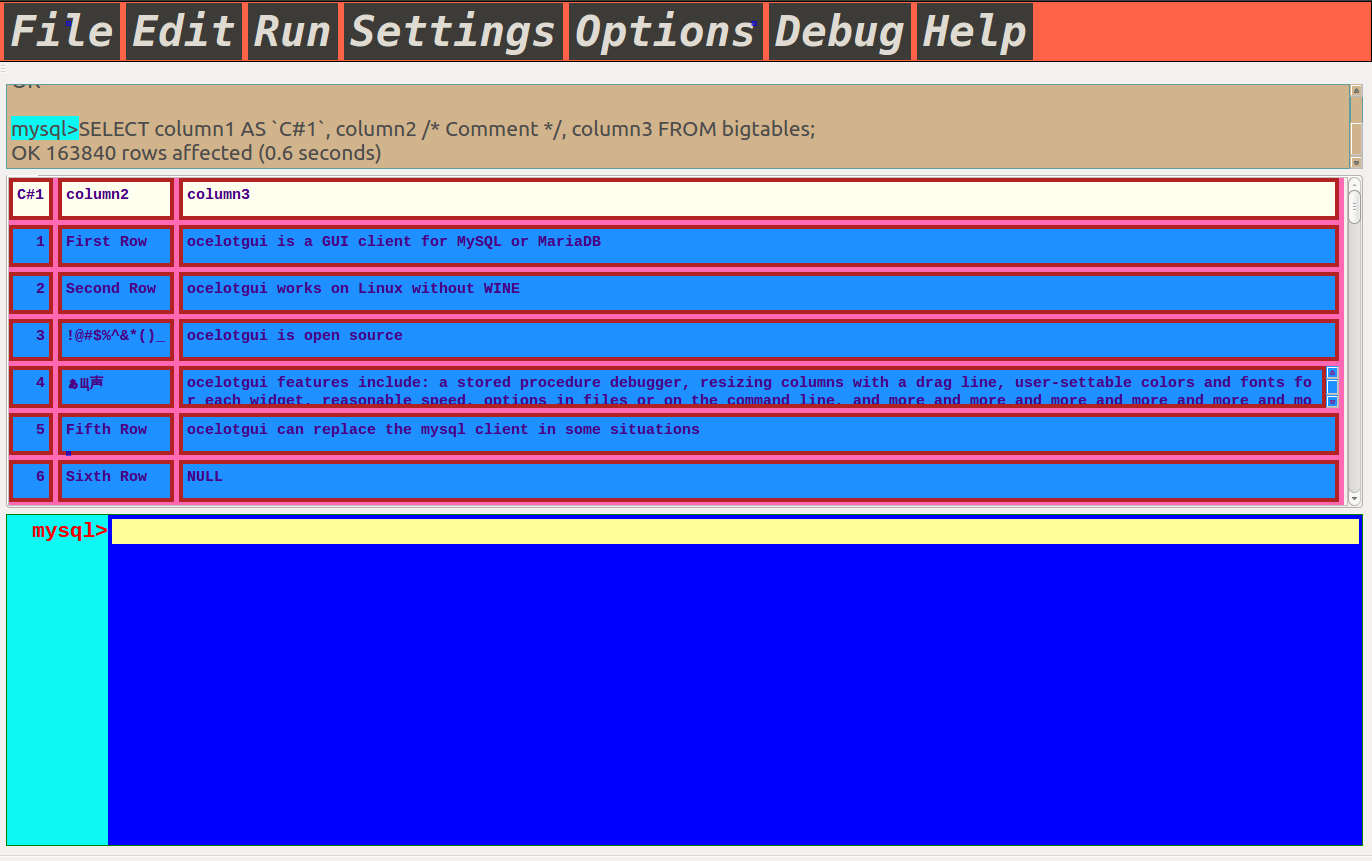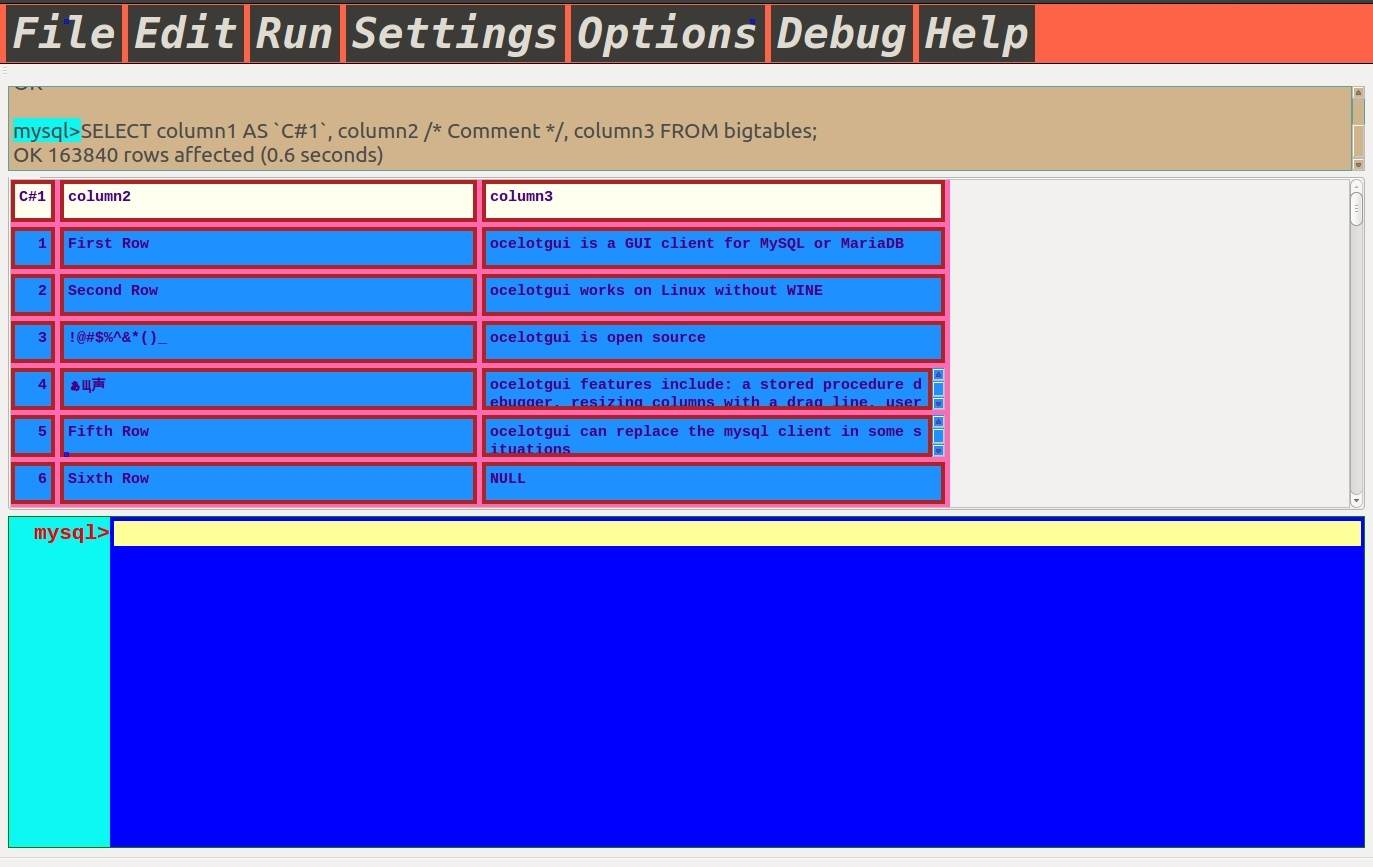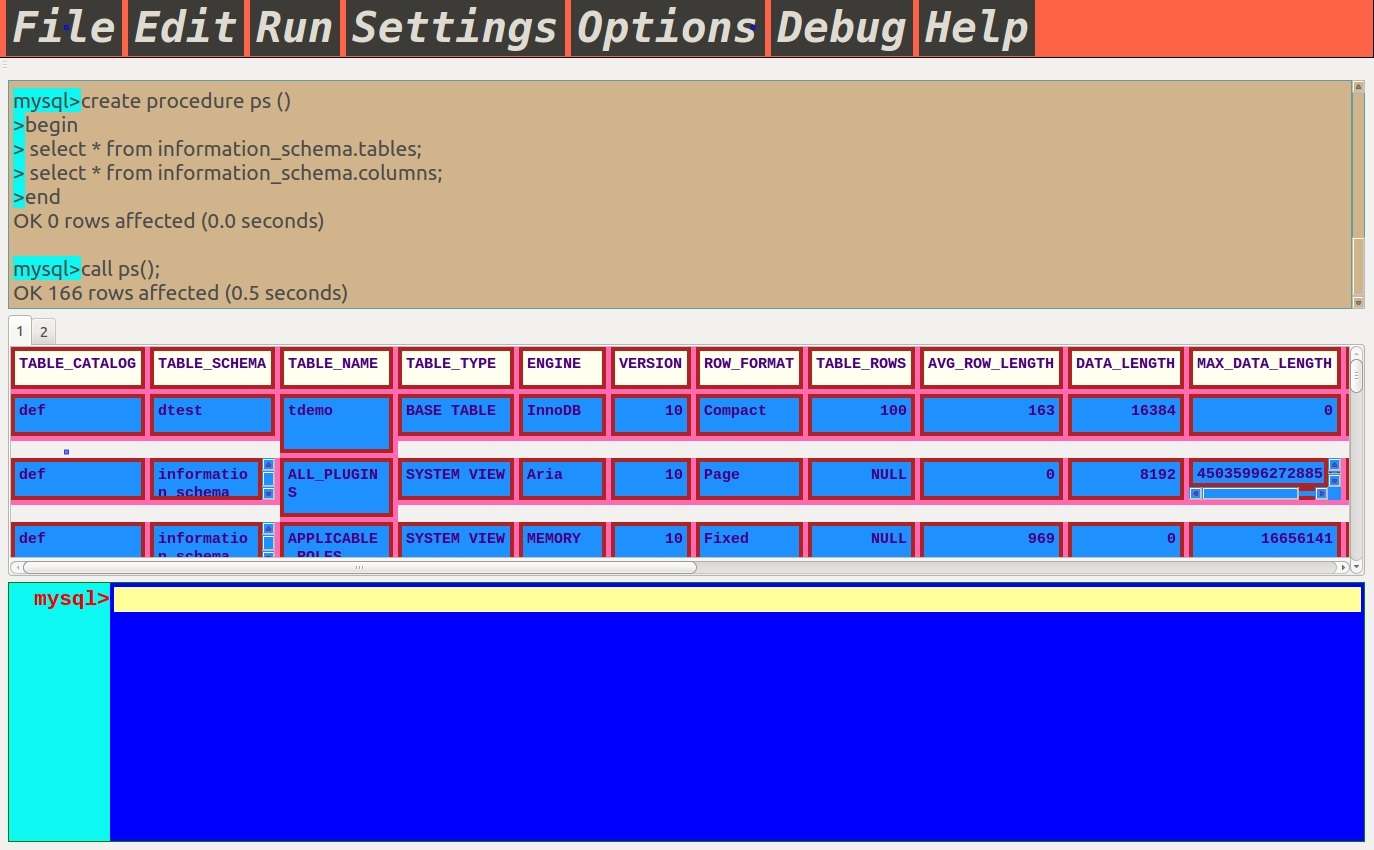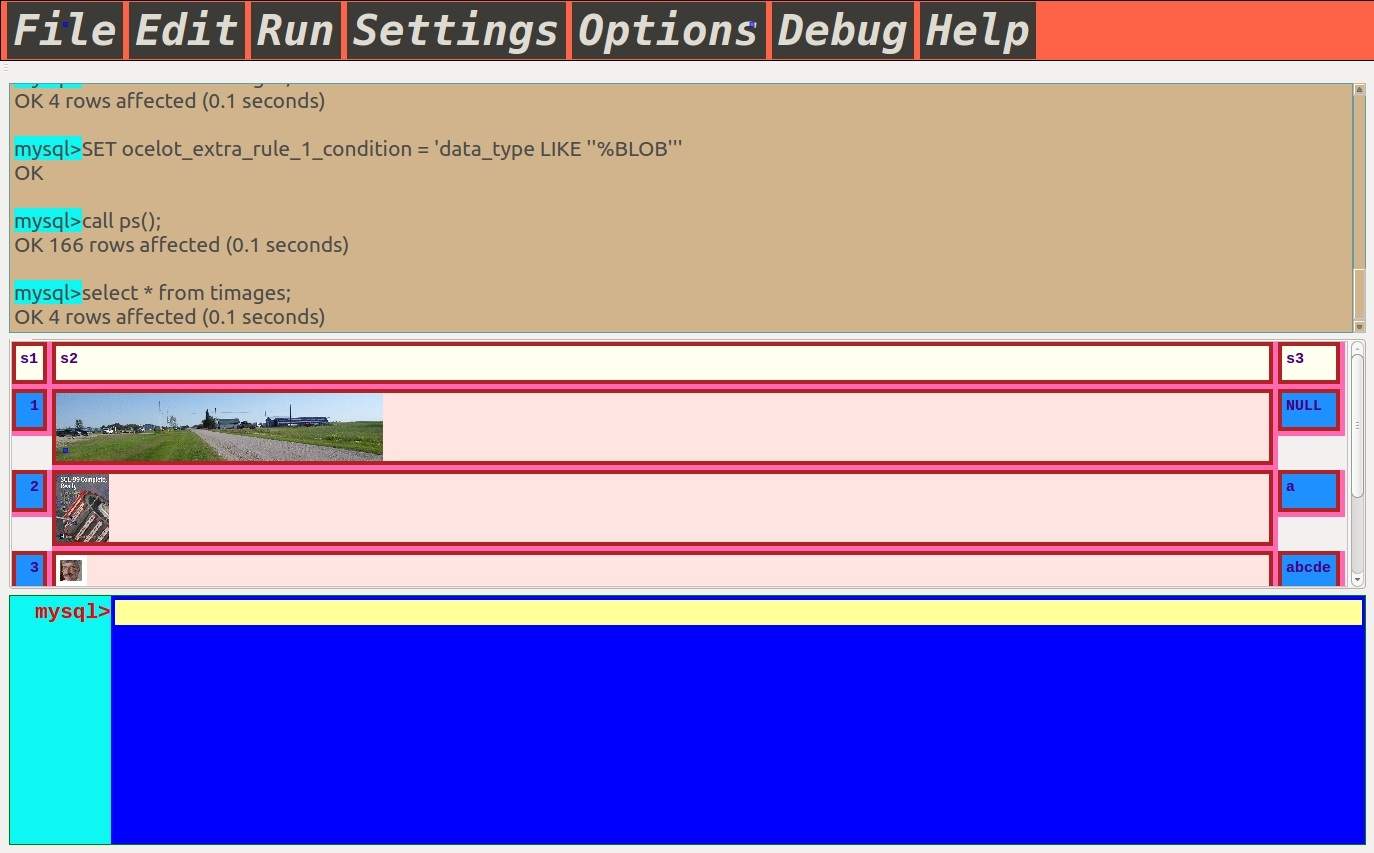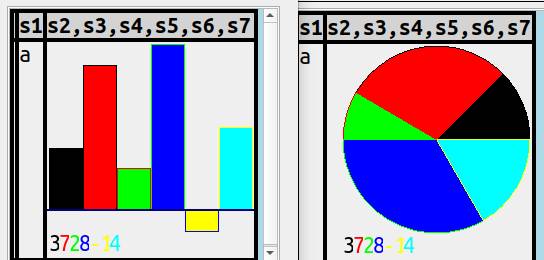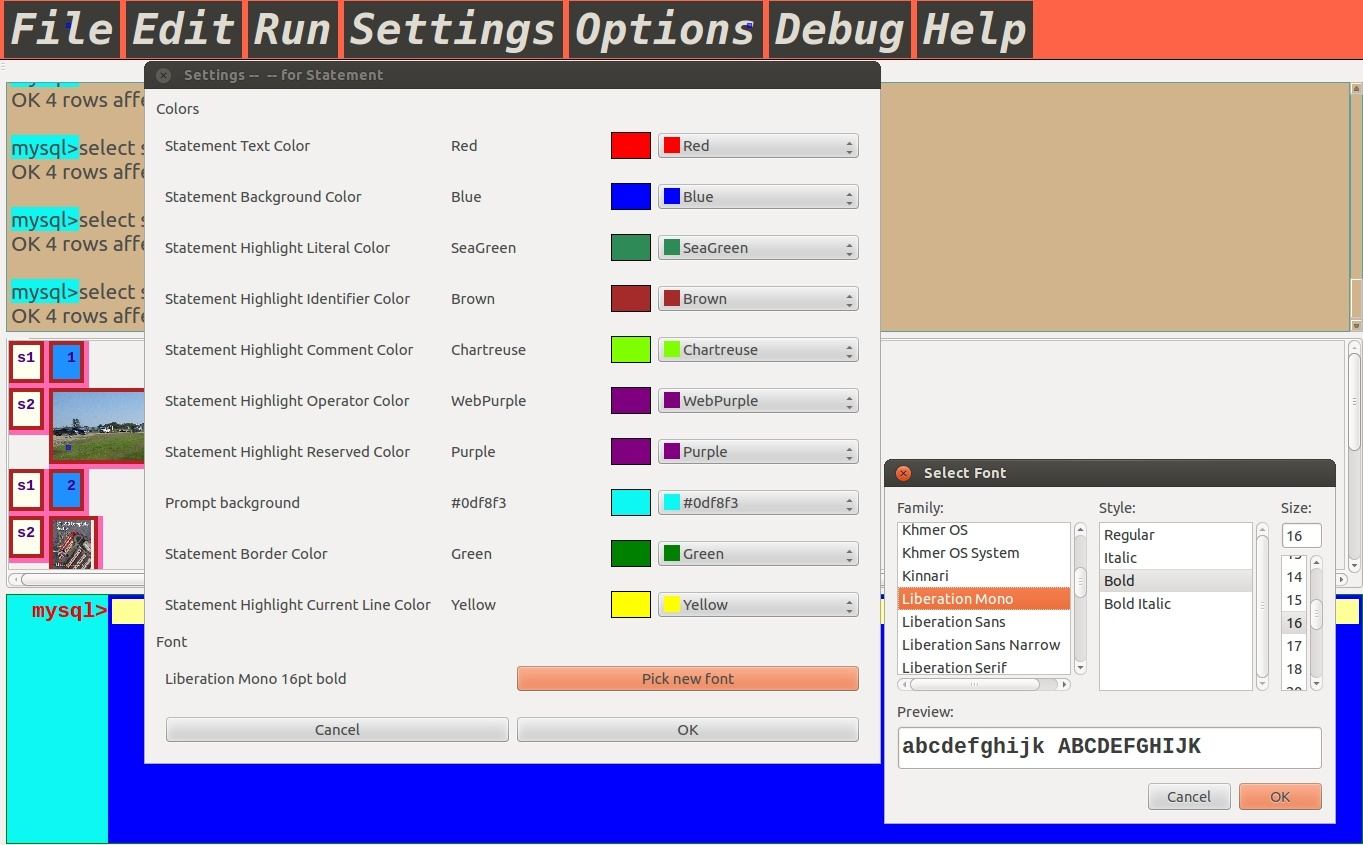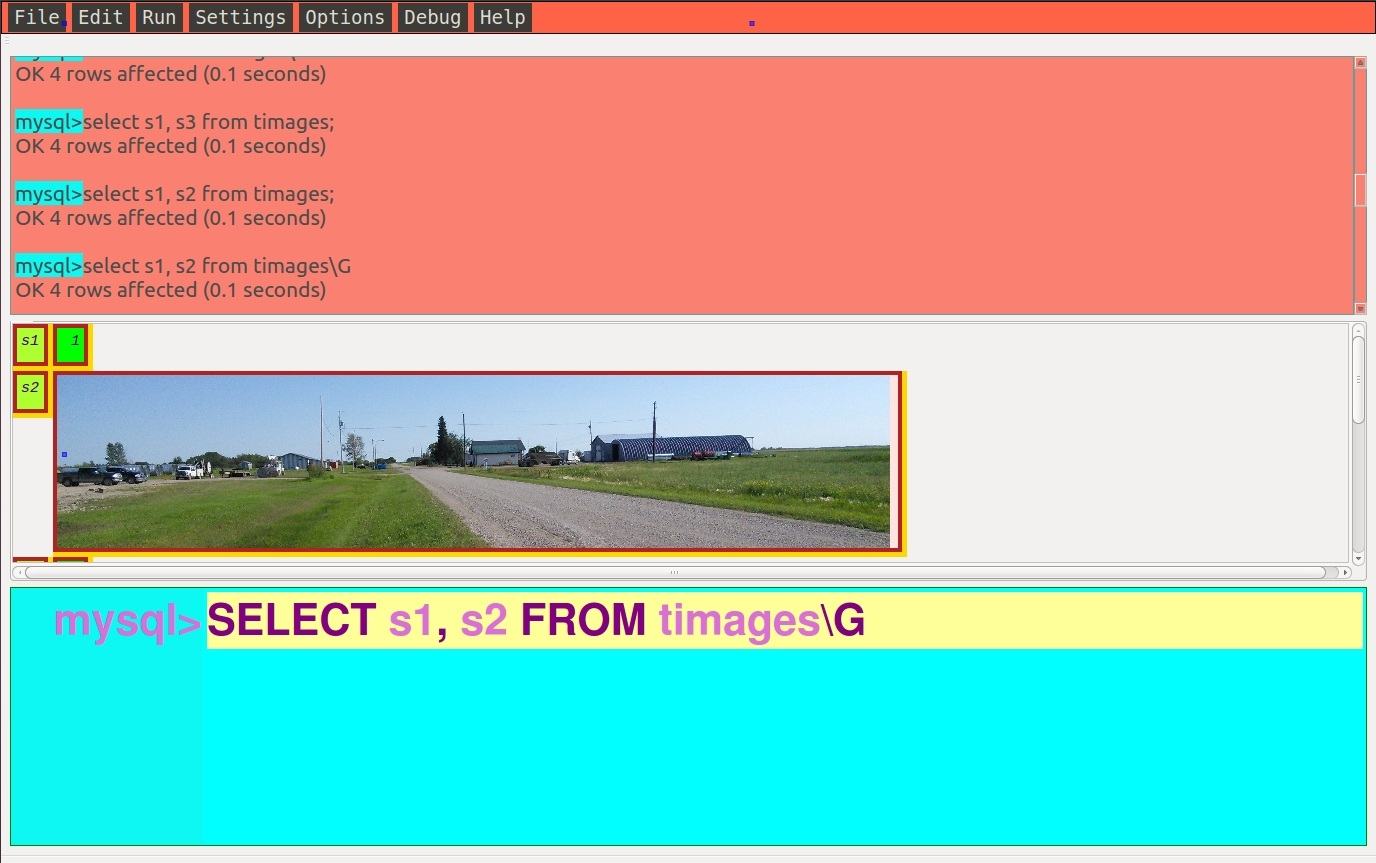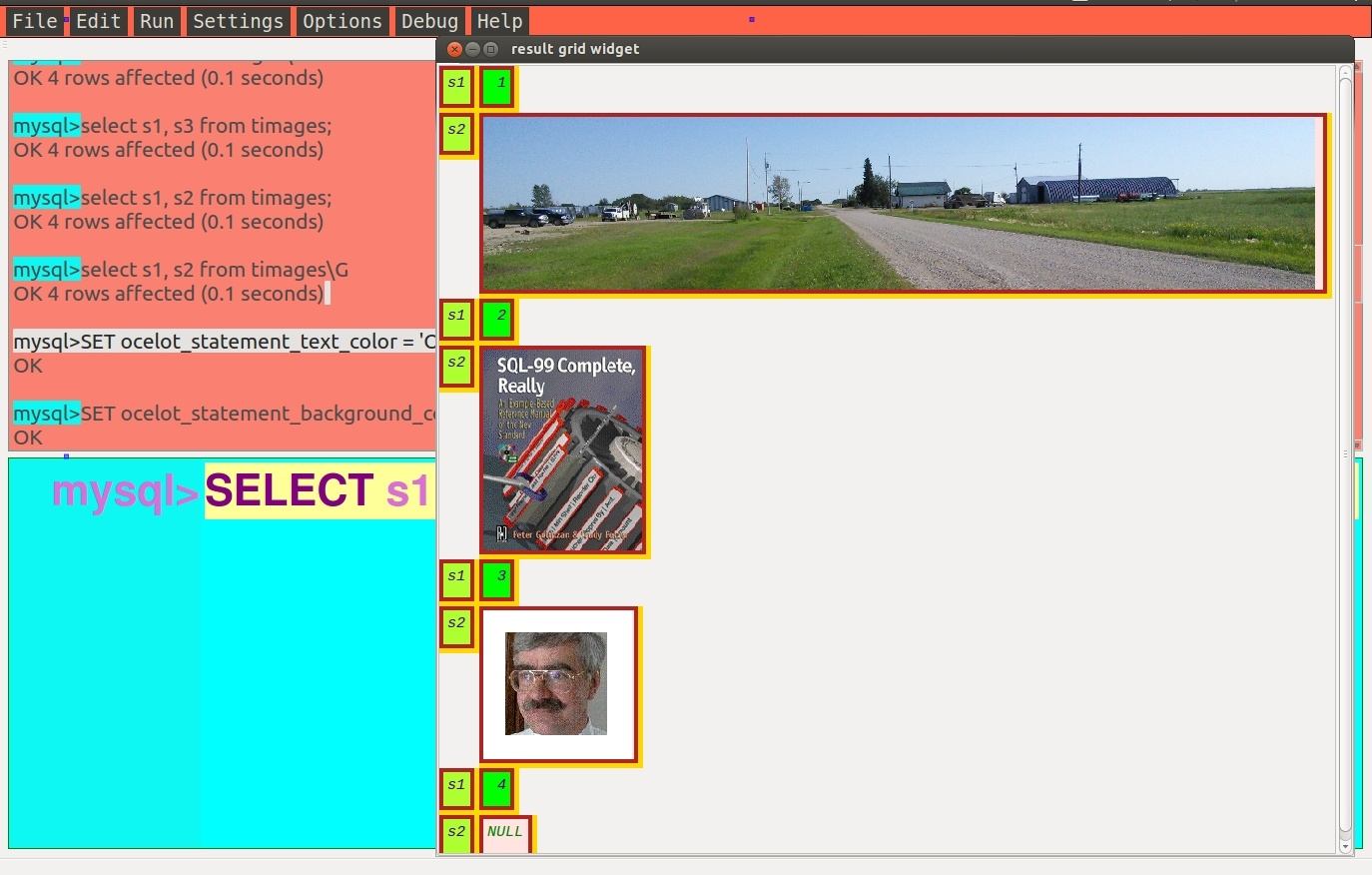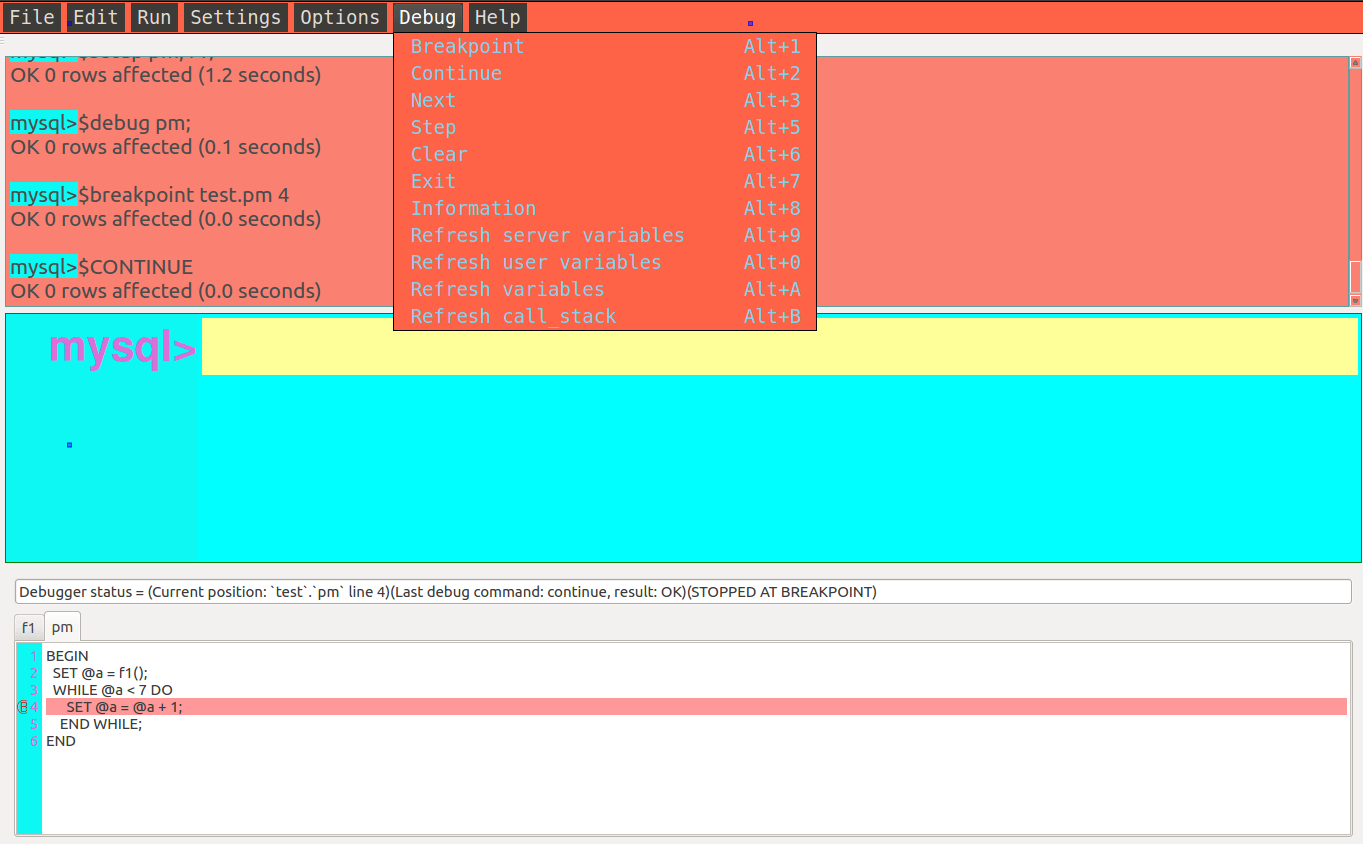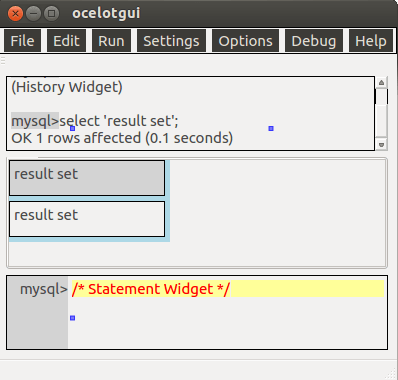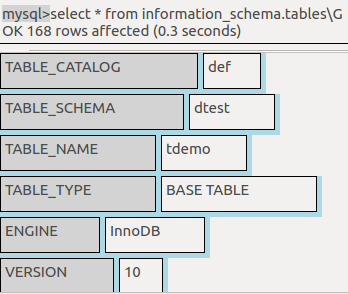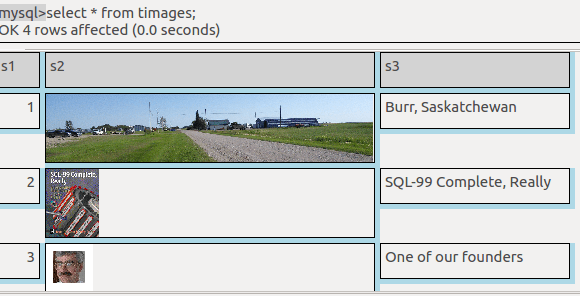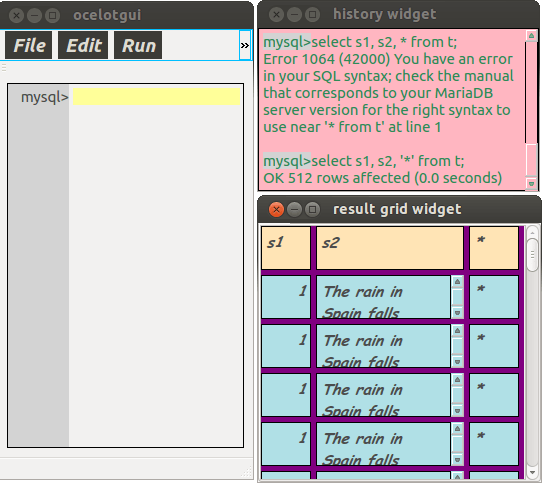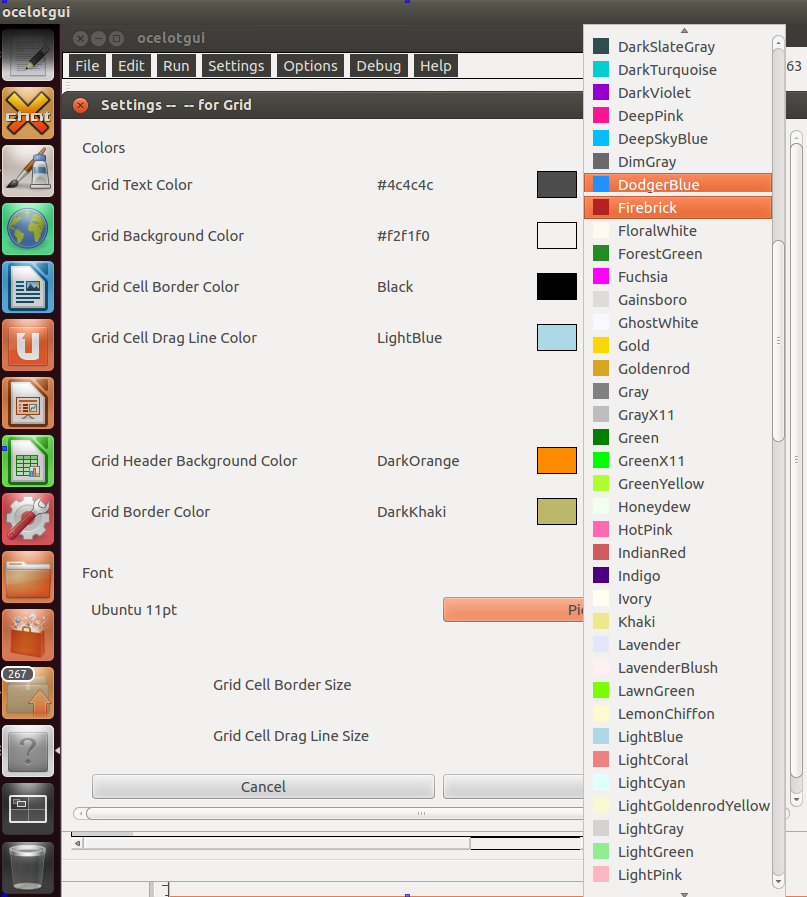

Ocelot Computer Services Inc.
source link: http://ocelot.ca/
Go to the source link to view the article. You can view the picture content, updated content and better typesetting reading experience. If the link is broken, please click the button below to view the snapshot at that time.
Ocelot Computer Services Inc.
Makers of ocelotgui
Version 1.0.9
The Ocelot GUI (ocelotgui), a database client, allows users to connect to a MySQL or MariaDB DBMS server, enter SQL statements, and receive results. Some of its features are: syntax highlighting, user-settable colors and fonts for each part of the screen, result-set displays with multi-line rows and resizable columns, and a debugger.
Copyright (c) 2014-2019, Ocelot Computer Services Inc. All rights reserved.
For the GPL license terms see https://github.com/ocelot-inc/ocelotgui/blob/master/LICENSE.GPL.
For instructions for end users see the User Manual.
For ocelotgui screenshots see http://ocelot.ca/screenshots.htm.
For ocelotgui/debugger screenshots see http://ocelot.ca/blog/the-ocelotgui-debugger.
This README file has installation instructions, screenshots, and the user manual.
Contents
Installing
... Prerequisites ... Getting the Qt library ... Getting the libmysqlclient.so library ... Getting the ocelotgui executable package ... Starting the programIllustrating
... Some screenshotsUsing
... User Manual ... Executive Summary ... The company, the product, and the status ... Downloading, installing, and building ... Starting ... Statement widget ... Client statements ... History widget ... Result widget ... Menu ... Debugger ... Special effects ... ContactAppendixes
... Appendix 1 Details about ocelotgui options ... Appendix 2 Reference for the Ocelot GUI debugger ... Appendix 3 Tarantoo ... Appendix 4 windows ... Appendix 5 Getting and using the ocelotgui source
Prerequisites
The installation instructions in this section are for Linux. If you prefer to run on Windows, read the installation instructions in Appendix 4 windows and come back to read the User Manual section.
The basic prerequisites for installation are Linux, and the Qt library. The libmysqlclient library will also be necessary, at runtime.
Getting the Qt library
You probably will find that the Qt package is already installed, since other common packages depend on it. If not, your Linux distro's repositories will provide a Qt package. For example, on some platforms you can say "sudo apt-get install libqt5core5a" , on others you can say "dnf install qt qt-x11".
The Qt version number can be found with find /usr/lib -name "libQt*Gui.so*", or find /usr/lib64 -name "libQt*Gui.so*". If the response starts with libQtGui.so.4 then you have Qt4, if the response starts with libQt5Gui.so.5 then you have Qt5. Alternatively it sometimes can be found with qmake -v. Ocelot supplies executables only for Qt version 5, but if you have Qt version 4 you can build from source.
The Qt library is necessary for ocelotgui installation.
Getting the libmysqlclient.so library
You may find that the libmysqlclient.so library is already installed, if you have used a MySQL or MariaDB client program before. If not, your Linux distro's repositories will contain it, usually with a package name like "libmysqlclient-dev" or "libmysqlclient-devel".
With Fedora the package name may be "mariadb-devel" and the library name may be "libmariadb.so" or "libmariadbclient.so".A tip for Mageia 5: You can use "urpmf " to find what packages contain libmysqlclient.so. If the answer is lib64mariadb18, you can install it with: sudo urpmi lib64mariadb18.
A tip for openSUSE 13.1: if neither Qt nor libmysqlclient libraries exist, say:
sudo zypper install libqt5-devel sudo zypper install mariadb-client sudo zypper install libmysqlclient-devel
The important file is named "libmysqlclient.so" or something similar. If it is not already on the default path, then an error or warning will appear when you try to run ocelotgui. Find it, and say something like
export LD_RUN_PATH=[path to directory that contains libmysqlclient.so]Several other directories are searched; for details start ocelotgui after installation and choose Help | libmysqlclient.
The libmysqlclient library is not necessary for ocelotgui installation; however, it is necessary at runtime in order to connect to a MySQL or MariaDB server.
Getting the ocelotgui executable package
There are ocelotgui binary packages for platforms such as Ubuntu/Mint/MX where "Debian-like" packages
are preferred, or platforms such as Mageia/SUSE/Fedora (but not CentOS 7) where "RPM-like" packages
are preferred.
If one of the following ocelotgui binary packages is compatible with your platform,
cut and paste the corresponding pair of instructions onto your computer and
you can be up and running in about 15 seconds.
For 32-bit, Debian-like, Qt5
wget https://github.com/ocelot-inc/ocelotgui/releases/download/1.0.9/ocelotgui_1.0.9-1_i386.deb sudo apt install ./ocelotgui_1.0.9-1_i386.debFor 64-bit, Debian-like, Qt5
wget https://github.com/ocelot-inc/ocelotgui/releases/download/1.0.9/ocelotgui_1.0.9-1_amd64.deb sudo apt install ./ocelotgui_1.0.9-1_amd64.debFor 64-bit, RPM-like, Qt5
wget https://github.com/ocelot-inc/ocelotgui/releases/download/1.0.9/ocelotgui-1.0.9-1.x86_64.rpm sudo rpm -i ocelotgui-1.0.9-1.x86_64.rpmFor 64-bit, any Linux, Qt5
wget https://github.com/ocelot-inc/ocelotgui/releases/download/1.0.9/ocelotgui-1.0.9.tar.gz tar zxvf ocelotgui-1.0.9.tar.gz ocelotgui/ocelotgui-qt5For 64-bit, any Linux, Qt4 (deprecated)
wget https://github.com/ocelot-inc/ocelotgui/releases/download/1.0.9/ocelotgui-1.0.9.tar.gz tar zxvf ocelotgui-1.0.9.tar.gz ocelotgui/ocelotgui-qt4
Starting the program
After installing and making sure that ocelotgui is on the path, start it with
ocelotguior use options, for example
ocelotgui --host=127.0.0.1 --user=joe --password=secret-- if the program starts, and menu items such as Help|Manual work, then installation is successful. Stop again with File|Exit or control-Q.
Warning: Some menu shortcut keys may not work properly with Ubuntu 14.04.
Some screenshots

User Manual
Version 1.0.9, June 29 2019
Copyright (c) 2014-2019 by Ocelot Computer Services Inc. All rights reserved.
This program is free software; you can redistribute it and/or modify it under the terms of the GNU General Public License as published by the Free Software Foundation; version 2 of the License.
This program is distributed in the hope that it will be useful, but WITHOUT ANY WARRANTY; without even the implied warranty of MERCHANTABILITY or FITNESS FOR A PARTICULAR PURPOSE. See the GNU General Public License for more details.
You should have received a copy of the GNU General Public License along with this program; if not, write to the Free Software Foundation, Inc., 51 Franklin St, Fifth Floor, Boston, MA 02110-1301 USA
Executive Summary
The ocelotgui application, more fully 'The Ocelot Graphical User Interface', allows users to connect to a MySQL or MariaDB DBMS server, enter SQL statements, and receive results. Some of its features are: syntax highlighting, user-settable colors and fonts for each part of the screen, and result-set displays with multi-line rows and resizable columns, and a debugger.
The company, the product, and the status
Ocelot Computer Services is a Canadian company which has specialized in database products for thirty years. Its main employees worked for MySQL AB and Sun Microsystems and Oracle between 2003 and 2011.
The ocelotgui program is a front end which connects to MySQL (tm) or MariaDB (tm). In some ways it is like the basic mysql client program, with added GUI features: full-screen editing, syntax highlighting, tabular display, customized fonts and colors. It differs from some other front-end GUI products because it is open source (GPL), it is written in C++, and it makes use of the Qt multi-platform widget library.
The product status is: stable. It has been known to work as described in this manual on several Linux distros. It is stable, in the sense that there are no known severe errors and the features are frozen until the next version. Ocelot will address any bug reports and will answer any questions.
Downloading, installing, and building
To download the product go to https://github.com/ocelot-inc/ocelotgui. Instructions for installation will be in the README.md file. This location may change, or alternate locations may appear. If so there will either be an announcement on github or on ocelot.ca.
The package contains source code and an executable file named ocelotgui.
Starting
There must be an instance of MySQL or MariaDB running somewhere.
If connection is possible with the mysql client and does not require
unusual options, then connection is possible with ocelotgui. If there is
a my.cnf file, ocelotgui will read it, just as the mysql client would.
If there are connection-related options on the command line, ocelotgui
will accept them just as the mysql client would. Therefore the typical
way to start the program is to say
ocelotgui [--option [--option...]]
For a description of options see Appendix 1 Details about ocelotgui options.
If a password is required but not supplied, a dialog box will appear. Or, if the initial attempt to connect fails, an error message will appear saying it is necessary to choose File|Connect, which will cause the dialog box to appear. The dialog box has many possible settings (see the list in Appendix 1; however, for getting started, the ones that matter most are the ones at the top: host, port, user, socket, password, protocol. If the connection still fails, then ocelotgui will still come up, but only non-DBMS tasks such as screen customizing will be possible.
In any case, an initial screen will appear. After some activity has
taken place, the screen will have four parts, from top to bottom:
menu
history widget, where retired statements and diagnostics end up
results widget, where SELECT result sets appear
statement widget, where users can type in instructions.
Initially, though, only the menu and statement widget will appear.
Again, this should be reminiscent of the way the mysql client works: statements are typed at the bottom of the screen, and appear to scroll off the top after they are executed, with results in the middle.
Statement widget
The statement widget is an editable multi-line text box. The usual control keys that work on other text editors will work here too; see the later description of Menu Item: Edit.
The program includes a syntax checker and can recognize the parts of speech in MySQL grammar. It will do syntax highlighting by changing the color, for example comments will appear in light green, identifiers in green, operators in dark gray, and so on. The colors can be customized, see the later description of Menu Item: Settings.
The left side of the statement widget is reserved for the prompt, and cannot be typed over. Initially the prompt will be 'mysql>' but this can be changed, see the later description of Client Statements: Prompt.
For example, this screenshot shows the statement widget after the user has changed the default prompt and entered an SQL statement. The statement has keywords in magenta, literals in dark green, operators in light green, and comments in red. The prompt on the left has a gray background.
Major Feature Alert: this is not merely a GUI that only will highlight words that are in a list of keywords. This GUI will parse the complete MySQL or MariaDB grammar, without needing to ask the server. So the highlighting will be correct, syntax errors will be underlined in red, and -- since the parsing method is predictive -- there will be continuous hints about what word is expected next, and optionally an error message explaining suspected syntax problems before they go to the server.
Once a statement has been entered and is ready to be executed, the user can hit control-E, choose menu item Run|Execute, or place the cursor at the end of the text (after the ';' or other delimiter) and type Enter. It is legal to enter multiple statements, separated by semicolons, and then execute them in a single sequence.
Client statements
A client statement is a statement which changes some behavior of the client (that is, of the ocelotgui front end) but does not necessarily go to the MySQL/MariaDB server. Of the statements that the MySQL Reference manual describes in section 'mysql commands' http://dev.mysql.com/doc/refman/5.6/en/mysql-commands.html the ocelotgui program has working equivalents for: clear, delimiter, exit, prompt, source, tee, and warnings. For example, entering 'quit;' followed by Enter will cause the program to stop. It is sometimes not mandatory to end a client statement with ';', but is strongly recommended.
There are some enhancements affecting the PROMPT statement. The special sequence '\2' means 'repeat the prompt on all lines', and the special sequence '\L' means 'show line numbers'. For example, 'PROMPT \2\Lmariadb;' will change the prompt so that each line begins with '[line number] mariadb>'.
History widget
Once a statement has been executed, a copy of the statement text and the diagnostic result (for example: 0.04 seconds, OK) will be placed in the history widget. Everything in the history widget is editable including the prompt, and it simply fills up so that after a while the older statements are scrolled off the screen. Thus its main function is to show what recent statements and results were. Statements in the history can be retrieved while the focus is on the statement widget, by selecting 'Previous statement' or 'Next statement' menu items.
Initially the history widget will show some statements from past sessions which are stored in a history file.
Result widget
If a statement is SELECT or SHOW or some other statement that returns a result set, it will appear in the result widget in the middle area of the screen. The result widget is split up into columns. Each column has a header and details taken from what the DBMS returns.
The width of the column depends on the result set's definition, but extremely wide columns will be split onto multiple lines. That is, one result-set row may take up to five lines. If the data still is too wide or too tall to fit in the cell, then the cell will get a vertical scroll bar. The user can change the width of a column by dragging the column's right border to the right to make the column wider, or to the left to make it narrower.
The result widget as a whole may have a horizontal and a vertical scroll bar. The vertical scroll bar moves a row at a time rather than a pixel at a time -- this makes large result sets more manageable, but makes the vertical scroll bar unresponsive if each row has multiple lines and the number of rows is small.
For example, this screenshot shows the whole screen after the user has typed the statement "select * from information_schema.tables;" on the statement widget and then executed it. The statement text has been copied to the history widget, the statement widget has been cleared, the result widget has the rows. The user has dragged the border of the fourth column to the left, causing a scroll bar to appear.
The menu at the top of the screen has File, Edit, Run, Settings, Options, Debug and Help.
File|Connect, or Ctrl+O, starts the Connect dialog box. File|Exit, or Ctrl+Q, stops the program.
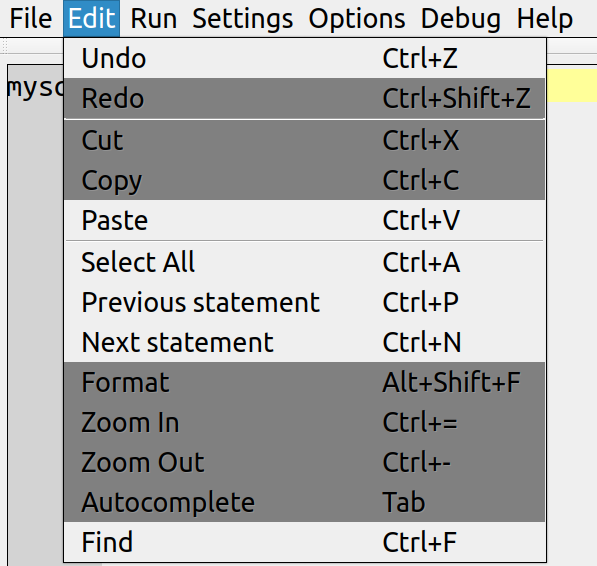 Edit|Undo or Ctrl+Z, Edit|Redo or Ctrl+Shift+Z, Edit|Cut or Ctrl+X,
Edit|Cut or Ctrl+X, Edit|Copy or Ctrl+C, Edit|Paste or Ctrl+V,
and Edit|Select or Ctrl+A, all work in the conventional manner.
Edit|Redo can only redo the last change.
Previous Statement or Ctrl+P and Next Statement or Ctrl+N will
copy earlier statements from the history widget into the statement
widget, so that they can be edited or re-executed with Run|Execute
or Ctrl+E.
Edit|Undo or Ctrl+Z, Edit|Redo or Ctrl+Shift+Z, Edit|Cut or Ctrl+X,
Edit|Cut or Ctrl+X, Edit|Copy or Ctrl+C, Edit|Paste or Ctrl+V,
and Edit|Select or Ctrl+A, all work in the conventional manner.
Edit|Redo can only redo the last change.
Previous Statement or Ctrl+P and Next Statement or Ctrl+N will
copy earlier statements from the history widget into the statement
widget, so that they can be edited or re-executed with Run|Execute
or Ctrl+E.
Run|Execute or Ctrl+E or Ctrl+Enter causes execution of whatever is in the statement widget. Run|Kill or Ctrl+C tries to stop execution -- this menu item is enabled only when a long-running statement needs to be aborted by user intervention.
Settings|Menu, Settings|History Widget, Settings|Grid Widget, Settings|Statement, and Settings|Extra Rule 1 are items which affect the behavior of each individual widget. The color settings affect foregrounds, backgrounds, borders, and (for the statement widget only) the syntax highlights. The font settings affect font family, boldness, italics, and size. Font settings involve further dialog boxes which are standard with Qt. There may be additional choices affecting appearance, for example the width of the border used to drag columns in the result widget. Settings|Extra Rule 1 is conditional -- for example, to specify that BLOBs should be displayed as images on a pink background, set Grid Background Color Pink, set Condition = data_type LIKE '%BLOB', set Display As = image, then click OK.
Options|detach history widget, Options|detach result grid widget, Options|detach debug widget are for turning the respective widgets into independent windows, so that they can be moved away from the statement widget, or resized. A detached widget is always kept on top of the other widgets in the application screen. When a widget is already detached, the menu item text will change to "attached" and clicking it will put the widget back in its original position.
The items on the Debug menu are enabled only when a debug session is in progress. The way to debug SQL stored procedures or functions will be explained in a later section.
Help|About will show the license and copyright and version. Help|The Manual will show the contents of README.md (the manual that you are reading) if README.md is on the same path as the ocelotgui program; otherwise it will show a copyright, a GPL license, and a pointer to README.md. Help|libmysqlclient will advise about finding and loading the libmysqlclient.so library. Help|settings will advise about how to use the Settings menu items.
Debugger
It is possible to debug stored procedures and functions. This version of ocelotgui incorporates MDBug (read about MDBug at http://bazaar.launchpad.net/~hp-mdbug-team/mdbug/trunk/view/head:/debugger.txt). All debugger instructions can be entered on the ocelotgui command line; some operations can also be done via the Debug menu or by clicking on the stored-procedure display. Currently-supported instructions are:
$install -- this is always the first thing to do.
$setup routine_name [, routine_name ...] -- prepares so '$debug routine_name' is possible.
$debug routine_name -- starts a debug session, shows routines in a tabbed widget.
$breakpoint routine_name line_number or Debug|breakpoint -- sets a breakpoint.
$clear routine_name line_number -- clears a breakpoint.
$next or Debug|Next -- goes to next executable line, without dropping into subroutines.
$step or Debug|Step -- goes to next executable line, will drop into subroutines.
$continue or Debug|Continue -- executes until breakpoint or until end of procedure.
$refresh breakpoints -- refreshes xxxmdbug.breakpoints table.
$refresh server_variables -- refreshes xxxmdbug.server_variables table.
$refresh variables -- refreshes xxxmdbug.variables table.
$refresh user_variables -- refreshes xxxmdbug.user_variables table.
$exit or Debug|Exit -- stops a debug session.
For a walk through a debugger example, with screenshots, see this blog post: http://ocelot.ca/blog/the-ocelotgui-debugger. For reference, read: Appendix 2 Reference for the Ocelot GUI debugger (ocelotgui)">.
Special Effects
Vertical: If a user starts the program with ocelotgui --vertical=1 or ends a statement with backslash G, results come up with one column per row.
Images: If a user chooses Settings | Extra Rule 1 from the menu, and sets the Condition and Display As boxes as described earlier, and selects rows which contain LONGBLOB columns, and the column values are images (such as PNG or JPEG or BMP or GIF format data), ocelotgui will display the result as images.
Result-set editing: If a user clicks on a column in the result set and makes a change, an update statement will appear in the statement widget. For example, if a result set is the result from SELECT column1, column2 FROM t;, and the column1 value is 5, and the column2 value is 'ABC', and the user changes the column2 value to 'AB', then the statement widget will show UPDATE t SET column2 = 'AB' WHERE column1 = 5 AND column2 = 'AB';. The user then has the choice of ignoring the update statement or executing it.
Detaching: If a user chooses Options | detach history widget or Options | detach result grid widget, then the widget will become a separate window which can be moved or resized.
Colors: The Colors and fonts dialog boxes have a simple way to choose colors, by selecting from a choice of 148 color names / color icons. Users can also change colors by saying SET object_name_color = color-name | hex-rgb-value. In fact ocelotgui mixes the modes: for example if a user chooses Settings | Grid Text Color, then clicks on the 'Red' icon, then clicks OK, ocelotgui generates a statement "SET ocelot_grid_text_color = 'Red';". This makes the instruction easy to repeat or put in a script.
RE: SQL_MODE. To distinguish between literals and identifiers enclosed in double quotes, ocelotgui needs to know the value of sql_mode (ansi_quotes). It calculates this automatically; however, in rare circumstances it can fail to detect changes on the server. If that appears to be the case, say SET SESSION SQL_MODE = @@SESSION.SQL_MODE; to update it.
RE: TAB COMPLETION. While a user is entering an SQL statement, ocelotgui will display a list of possible words that may follow. Hitting the Tab key will cause the first word in the list to be displayed and accepted.
RE: HINTING FOR COLUMN NAMES. Although hints for syntax appear by default, hints for table / column identifiers do not. In order to make identifiers appear on the hint list: (1) ensure the setting for auto_rehash has not been turned off; (2) enter the statement "REHASH;" to make the client ask the server for a list of identifiers in the current database; (3) when entering an SQL statement, type ` (backtick) at the point where an identifier is expected.
RE: FONT. By default, ocelotgui uses a fixed-pitch (mono) font that has similar attributes to whatever font was in use at the time it started. This may be a bad choice. We recommend trying out other fonts with the Settings menu for each widget.
RE: PERMANENT CUSTOMIZING. Changes to settings can be done with the Settings menu items, but such changes are not permanent. So note the commands that ocelotgui performs when settings are changed, and paste them into a file. Later this file can be executed (for example with SOURCE file-name), whenever ocelotgui is started again. Alternatively, settings can be placed in an options file such as my.cnf.
RE: DEBUGGING WITH MYSQL 5.7. Oracle has made a significant incompatible behavior change in version 5.7, which affects the debugger. The originally recommended workaround was to say "set global show_compatibility_56=on;". We believe we made a more permanent fix for this problem in ocelotgui version 1.0.8.
RE: CONNECTION DIALOG. As stated earlier, if a password is necessary to connect, it is sufficient to start ocelotgui with "--password=password" or by choosing File|Connect and typing a password in the Password field (the sixth field in the Connection Dialog Box). Also on the Connection Dialog Box, if the server is running on the same computer as the ocelotgui client, it is sometimes a good idea to enter '127.0.0.1' in the host field, instead of 'localhost'.
RE: ROW NUMBERS. Ocelot will replace the value 'row_number() over ()'
with the row number within the result set. For example, try
SELECT 'row_number() over ()' as r, table_name.* FROM table_name;
To disable this feature, start ocelotgui with --ocelot_client_side_functions=0.
RE: HOVERING. Use the mouse to hover over a word in the statement widget, and Ocelot will display what kind of word it is, for example "table identifier".
RE: FORMAT. Click Edit|Format, and Ocelot will change the contents of the statement widget so that keywords are upper case and sub-clauses or sub-statements are indented.
RE: HISTORY. By default the history does not contain any rows from result sets of previous statements. To change this, click Settings|History and enter a number for Max Row Count.
RE: TARANTOOL. By default ocelotgui is a client for MySQL or MariaDB. To use it as a client for Tarantool, read Appendix 3 Tarantool.
Contact
We need feedback!
Registered github users can simply go to https://github.com/ocelot-inc/ocelotgui and click the "Star" button.
Send bug reports and feature requests to https://github.com/ocelot-inc/ocelotgui/issues. Or send a private note to pgulutzan at ocelot.ca.
There may be announcements from time to time on Ocelot's web page (ocelot.ca) or on the employee blog (http://ocelot.ca/blog).
Any contributions will be appreciated.
Appendix 1 Details about ocelotgui options
An option is a named value which affects connecting and behavior.
Most Ocelot options are very similar to options of the mysql client.
The places that an option might be specified are:
within the program for example the default port value is 3306,
in an environment variable for example "export MYSQL_TCP_PORT=3306",
in a configuration file for example "port=3306" in $HOME/.my.cnf,
on the command line for example "./ocelotgui --port=3306",
or on the File|Connect dialog box.
Environment Variables. The ocelotgui program will look at these variables:
HOME, LD_RUN_PATH, MYSQL_GROUP_SUFFIX, MYSQL_HISTFILE,
MYSQL_HISTIGNORE, MYSQL_HOST, MYSQL_PS1, MYSQL_PWD.
MYSQL_TCP_PORT, MYSQL_UNIX_PORT, MYSQL_TEST_LOGIN_FILE.
Option Files: The ocelotgui program will look in these option files:
/etc/my.cnf, /etc/mysql/my.cnf, [SYSCONFDIR]/my.cnf,
[defaults-extra-file], $HOME/.my.cnf, $HOME/.mylogin.cnf.
Within option files, the ocelotgui program will look
in these groups: [client] [mysql] [ocelot], as well
as groups specified by MYSQL_GROUP_SUFFIX.
On Windows, the order is different: %system, %windir,
[application-directory], %MYSQL_HOME%, [defaults-extra-file].
Command Line: The ocelotgui program will look at command-line arguments
which are specified in short form such as "-p 3306", or
which are specified in long form such as "--port=3306".
Dialog Box: A dialog box will appear if the user enters a user statement
"CONNECT;" or if the user chooses menu item File|Connect.
The user will be advised to do this at startup time if an
initial attempt to connect fails.
Example
The default value for "port" is 3306, this is
hard coded in the ocelotgui source.
The environment variable value for "port" is 3307, this is
set by "export MYSQL_TCP_PORT=3307" before starting ocelotgui.
The option file value for "port" is 3308, this is
set by putting "PORT=3308" in the [mysql] group in
the $HOME/.mysql.cnf file.
The command-line value for "port" is 3309, this is
set by putting "--port=3309" on the command line
when starting the ocelotgui program.
The dialog-box value for "port" is 3310, this is
set by choosing File|Connect, entering "3310" in
the widget labelled "Port", and clicking "OK".
The ocelotgui program reads the settings in the
above order, therefore the port number is 3310.
Options in the following table are in the same order that one sees
on the File|Connect dialog box: first come the 8 important connect
options (host, port, user, database, socket, password, protocol,
init_command), then all the other options in alphabetical order.
Unless otherwise stated, options are specifiable by saying
[option_name] = [value] in an option file or
--[option_name] = [value] on the command line
(sometimes --[option_name] alone is sufficient for true|false values),
or in the dialog box.
If an option value is irrelevant or invalid, the ocelotgui program
ignores it without displaying an error message.
See also: the example.cnf file. Option Description host Server address. Specifiable with MYSQL_HOST environment variable, with host= in an option file, with -h or --host on the command line, or in dialog box. Example values: localhost 192.15.8.44 [email protected]. Warning: if host=localhost, ocelotgui tries to use a socket, if this is not desirable then say localhost=127.0.0.1 instead. port Port that the server listens on, if the protocol is TCP. Specifiable with MYSQL_TCP_PORT environment variable, with port= in an option file, with -P or --port on the command line, or in dialog box. Example values: 3306 3307. user User name. Specifiable with user= in an option file, with -u or --user on the command line, or in dialog box. Example values: root guest jsmith. database Database name also known as schema name. Specifiable with database= in an option file, with -D or --database on the command line, or in dialog box. Example values: test account_data.
socket Socket name that the server receives on, if the protocol is SOCKET. Specifiable with socket= in an option file, with -S or --socket= on the command line, or in dialog box. Examples: var/lib/special.sock /home/user/x.sock.
password Password associated with the user. Specifiable with password= in an option file, with -p or --password= on the command line, or in dialog box. If the password is required but not specified, the dialog box will always appear. Examples: sesame top_secret#1 protocol How the connection to the server occurs. Possible values are: blank or TCP or SOCKET. If host=localhost and protocol is blank, then SOCKET is assumed. Specifiable with protocol= in an option file, with --protocol= on the command line, or in dialog box. Examples: tcp socket. init_command Initial statement that should be executed as soon as connect is complete. Example: "select current_user()". auto_rehash If 1 (true), ocelotgui may try to complete names. auto_vertical_output If 1 (true), ocelotgui will display with one column per row. batch Mostly ignored, but if 1 (true), history is not written. compress If 1 (true), value is passed to the server. connect_expired_password If 1 (true), ocelotgui goes into sandbox mode if a password has expired at connect time. connect_timeout Ignored. debug Ignored. debug_check Ignored. debug_info Ignored. default_auth Ignored. default_character_set Ignored, ocelotgui needs UTF-8. defaults_extra_file Name of an additional option file. defaults_file Ignored. defaults_group_suffix Suffix that is added to the regular group names for option files. For example, if defaults_group_suffix=_X, then ocelotgui will look at options in groups client_X and mysql_X and ocelot_X in addition to options in groups client and mysql and ocelot. delimiter What ends a statement, usually semicolon ";". enable_cleartext_plugin Ignored. execute String to execute followed by program exit. force Ignored, ocelotgui always ignores errors in options. help Display a help message followed by program exit. histfile Name of file where statements are logged to, usually ".mysql_history". Ignored if batch=1. Ignored if histfile=/dev/null. histignore Pattern to ignore when writing to histfile. For example, if histignoreis "*select*", then statements containing the string "select" will not be written. html If one starts ocelotgui with --html, the grid display will be based on HTML rather than on widgets, making results look quite different. If one starts ocelotgui with --html --raw, the actual html markup code will appear. ignore_spaces Ignored. ld_run_path Where to look for libmysqlclient.so. Click help|libmysqlclient for details. line_numbers Ignored. local_infile If 1 (true), passed to the server. login_path Where to find login file if it's not "~/.mylogin.cnf". max_allowed_packet Passed to the server. Default 16777216.
max_join_size Passed to the server. Default 1000000. named_commands Ignored. net_buffer_length Passed to the server. Default 16384. no_beep Ignored, ocelotgui does not usually beep when errors occur. no_defaults If 1 (true), options in environment variables and option files are read but not used. ocelot_* ... Options that begin with "ocelot_" are only recognized by the ocelotgui client. Everything on the Settings menu has an associated option name. The intuitively-named settings options are: ocelot_extra_rule_1_text_color ocelot_extra_rule_1_background_color ocelot_extra_rule_1_condition ocelot_extra_rule_1_display_as ocelot_grid_text_color ocelot_grid_background_color ocelot_grid_border_color ocelot_grid_header_background_color ocelot_grid_font_size ocelot_grid_font_style ocelot_grid_font_weight ocelot_grid_cell_border_color ocelot_grid_cell_drag_line_color ocelot_grid_border_size ocelot_grid_cell_border_size ocelot_grid_cell_drag_line_size ocelot_grid_detached ocelot_history_text_color ocelot_history_background_color ocelot_history_border_color ocelot_history_font_family ocelot_history_font_size ocelot_history_font_style ocelot_history_font_weight ocelot_menu_text_color ocelot_history_detached ocelot_menu_background_color ocelot_menu_border_color ocelot_menu_font_family ocelot_menu_font_size ocelot_menu_font_style ocelot_menu_font_weight ocelot_statement_text_color ocelot_statement_background_color ocelot_statement_border_color ocelot_statement_font_family ocelot_statement_font_size ocelot_statement_font_style ocelot_statement_font_weight ocelot_statement_highlight_literal_color ocelot_statement_highlight_identifier_color ocelot_statement_highlight_comment_color ocelot_statement_highlight_operator_color ocelot_statement_highlight_keyword_color ocelot_statement_prompt_background_color ocelot_statement_highlight_function_color ocelot_statement_highlight_current_line_color ocelot_statement_detached. See also: the ocelot_ options which aren't related to Settings, below.ocelot_client_side_functions ocelot_client_side_functions=0 turns off the client-side functions, such as "select row_number() over ...". This may be unnecessary with newer versions of MariaDB. The default is 1. ocelot_dbms --ocelot_dbms=x means assume the server DBMS is x until connection is made. The possible values are 'mysql', 'mariadb', and 'tarantool'. The default is 'mysql'. ocelot_grid_tabs ocelot_grid_tabs=5 means assume that a stored procedure can return up to 5 result sets. The default is 16. ocelot_language --ocelot_language='english' means the menu and the client error messages should be in English, --ocelot_language='french' means the menu and the client error messages should be in French. The default is 'english'. ocelot_statement_syntax_checker setting ocelot_statement_syntax_checker=1 turns on the syntax checker; setting ocelot_statement_syntax_checker=2 turns on the syntax checker and is insistent -- if ocelotgui doesn't like the syntax checker, a confirmation dialog box will appear. The default is 1. ocelot_shortcut_* ocelot_shortcut_connect, ocelotshortcut_exit, etc. ... You can change what the shortcut is, for any menu item, by specifying its name and a new keysequence. For example: SET ocelot_shortcut_paste = 'Ctrl+Shift+K'; one_database Ignored. pager Ignored. pipe Ignored. plugin_dir Ignored. print_defaults If 1 (true), ocelotgui displays defaults and exits. prompt What to display on left of statement lines. Default is "mysql>". The prompt can include special character sequences for date, time, and line number. quick Ignored. raw Ignored. reconnect Ignored. safe_updates If 1 (true), ocelotgui passes 1 to the server. secure_auth If 1 (true), ocelotgui passes 1 to the server. select_limit The maximum number of rows to select; default is 0 which means infinity; ocelotgui passes this to the server. server_public_key Ignored. shared_memory_base_name Ignored. show_warnings If 1 (true), ocelotgui displays warnings which result from problems that the server detects. sigint_ignore If 1 (true), ocelotgui will not stop statements when user types control-C or chooses the menu item Run|Kill. silent Ignored. ssl_* ssl, ssl_ca, ssl_capath, ssl_cert, ssl_cipher, ssl_crl, ssl_crlpath, ssl_key, ssl_verify_server_cert. SSL options are accepted and passed to the server. syslog Ignored. table Ignored. tee Name of a file to dump statements and results to. unbuffered Ignored. verbose Ignored. version If 1 (true), ocelotgui displays a version number and exits. vertical If 1 (true), results are displayed with one column per line. wait Ignored. xml If one starts with ocelotgui --xml, the grid display will show raw xml. See also --html.
Appendix 2 Reference for the Ocelot GUI debugger (ocelotgui)
Before trying to read this reference, it is a good idea to become familiar with the ocelotgui client and try out the simple demonstration on the ocelot.ca blog.
Temporary warning: for debugging MySQL version 8.0 routines, you need a recent ocelotgui version as pushed to source on or after June 2018. Use ocelotgui version 1.0.7 or later.
All debug statements can be entered on the Statement widget,
optionally ending with ";".
Some debug statements can be invoked via the menu or with shortcut keys.
Like other statements, debug statements are editable, are logged,
and can cause error or warning messages to appear in the history.
Most statements can be entered even while the routine is running.
Warning: the focus can change, be sure that the cursor is blinking
on the Statement Widget and not on the Debug Widget before entering
a statement.
The following table shows statements in alphabetical order.
(Choosing from the menu may not work on some platforms.)Statement
What it's for
Syntax
Example
Remarks
$breakpoint
specifying a line where execution must stop.
$b[reakpoint [schema_identifier.] routine_identifier line_number [condition]
Shortcut:
Alt+1, or via menu: Debug|Breakpoint, or click on line
(If a shortcut is used, the breakpoint is set for
the routine that is currently being
displayed, for the line the cursor is on.)
$breakpoint test.p 5;
(The debugger must be running -- see $debug.)
If $breakpoint succeeds, a red marker will appear on
the left of the line. The breakpoint identifier will
be displayed on the Debug Widget.
Users can set breakpoints on any line.
Users should not set breakpoints twice on the same line.
Later, if the user enters $continue or $next,
execution may stop when a line with a breakpoint is seen.
To turn off a breakpoint, a user may click on the line
(it is a "toggle" switch), or see $clear and $delete.
Re condition:
A condition is an expression which must be true, otherwise
the breakpoint is ignored during execution. For example,
$breakpoint p20 5 x = 7;
sets a breakpoint which will only cause execution to halt
if x = 7. The expression must have the form
variable_name = literal, variable_name should be a
declared variable, and the literal should be numeric.
At time of writing, conditions are not well tested.
$clear
removing a breakpoint
$cl[ear] [schema_identifier.] routine_identifier line_number
Shortcut:
Alt+6, or via menu: Debug|Clear
(If a shortcut is used, the breakpoint is removed
for the routine that is currently being displayed,
for the line that the cursor is on.)
$clear p 5;
(The debugger must be running -- see $debug.)
(The breakpoint must exist (see $breakpoint.)
The breakpoint's red marker should disappear.
If it does not disappear, and a shortcut was used:
make sure the cursor is actually on the line, not
just on the line number, which is considered separate.
$continue
running the routine till it ends or till a breakpoint.
$co[ntinue]
Shortcut:
Alt+6, or via menu: Debug|Continue
$continue;
(The debugger must be running -- see $debug.)
$continue differs from $next and $step because it
does not halt on a following statement, it goes on
until it reaches a line with a breakpoint or until
the main routine ends.
$debug
beginning a debug session.
$deb[ug] [schema_identifier.] routine_identifier
[(parameter list)];
Shortcut:
None, $debug is not on the Debug menu.
$debug procedure21;
$debug function_x(7);
(The debugger must not be already running.
The routine must be set up -- $setup.)
The user must have appropriate privileges.)
If $debug is successful, then a Debug Widget
will appear (see section Debug Widget).
$exit
ending a debug session
$exi[t]
Shortcut:
Alt+7, or via menu: Debug|Exit
$exit;
(The debugger must be running -- see $debug.)
$information status
showing information about debugger status
$inf[ormation status]
Shortcut:
Alt+8, or via menu: Debug|Information
(Choosing from the menu may not work on some platforms.)
$information status;
select * from xxxmdbug. information_status;
The $information status statement will populate a table
named xxxmdbug. information_status, which contains
debugger_name, debugger_version,
timestamp_of_status_message, number_of_status_message,
icc_count, schema_identifier, routine_identifier,
line_number, is_at_breakpoint, is_at_tbreakpoint,
is_at_routine_exit, stack_depth, last_command,
last_command_result, commands_count.
The most important items of information status are
displayed automatically along with the Debug Widget,
so $information status is only for advanced users.
$install
install the debugger
$ins[tall]
Shortcut:
$install is not on the Debug menu.
$install;
(The user must have appropriate privileges.)
A large group of procedures and tables are
placed in a database named xxxmdbug.
Installation may take up to 20 seconds.
It is only necessary to run $install once,
but it may be redone, for example if a new
version of ocelotgui is used.
If $install is not done, none of the other
debug statements are possible.
$leave
exit from a loop without executing
$l[eave]
Shortcut:
None, $leave is not on the Debug menu.
Suppose this routine is being debugged:
begin
declare x int;
set x = 0;
while x < 5 do
set x = x + 0;
end while;
end
The user types $continue, which gets the
program running -- in an infinite loop.
One way to break out of the loop is with
"$set x = 6;", another way is with $leave.
($leave will also continue, so if you want
to stop after leaving you must set a brekapoint.)
(The debugger must be running --see $debug.)
(The procedure must be executing within a
loop.)
If the $leave statement is used when the
routine is not in a loop, consequences are
undefined -- this is not recommended.
$next
Making the program go to the next statement
in the current routine.
$n[ext];
Shortcut:
Alt+3, or via menu: Debug|Next
Suppose that the current line in procedure p is
select f() from t;
After $next, the current line changes to
the line following the select statement,
or (if this was the last line) routine exit.
(The debugger must be running --see $debug.)
$next is different from $step because $step
can drop into a subroutine, $next does not.
$refresh breakpoints
showing what breakpoints exist.
$refresh breakpoints;
Shortcut:
None. $refresh breakpoints is not on the Debug menu.
$refresh breakpoints;
select * from xxxmdbug. breakpoints;
The $refresh breakpoints statement will populate a table
named xxxmdbug. breakpoints, which contains
breakpoint_identifier, schema_identifier,
routine_identifier, routine_type, line_number_minimum,
line_number_maximum, condition_identifier,
condition_operator, condition_value, hit_count,
is_temporary, is_temporary_and_to_be_cleared,
is_matching_location, call_stack_depth_when_set,
command. For simple breakpoints which were set up with
$breakpoint schema.routine line_number,
$refresh breakpoints is unnecessary because
breakpointed lines are marked in the Debug Widget.
$refresh call_stack
showing what the routines are that got us here.
$refresh call_stack
Shortcut:
Alt+B, or via menu: Debug|Refresh call_stack
$refresh call_stack;
select * from xxxmdbug. call_stack;
Using menu Debug | Refresh call_stack will
cause two statements: $refresh and select.
The $refresh statement will populate a table
named xxxmdbug. call_stack, which contains
schema_identifier and routine_identifier and
routine_type and line_number, with one row
for each level. Thus, if routine p1 calls
p2 and routine p2 calls p3, there are three rows.
All $refresh statements may be blocked.
$refresh server variables
showing the contents of server variables.
$refresh server_variables
Shortcut:
Alt+9, or via menu: Debug|Refresh server_variables
(Choosing from the menu may not work on some platforms.)
$refresh server_variables;
select * from xxxmdbug. server_variables;
Using menu Debug | Refresh server_variables will
cause two statements: $refresh and select.
The $refresh statement will populate a table
named xxxmdbug. server_variables, which contains
variable_identifier and value and old_value.
For example, regardless what the routine is,
the available information will include that
there is a server variable named @@innodb_compression_level
which originally was null but now contains 6.
All $refresh statements may be blocked.
This statement is slow.
$refresh user variables
showing the contents of user variables.
$refresh user_variables
Shortcut:
Alt+A, or via menu: Debug|Refresh user_variables.
(Choosing from the menu may not work on some platforms.)
$refresh user_variables;
select * from xxxmdbug. user_variables;
Using menu Debug | Refresh user_variables will
cause two statements: $refresh and select.
The $refresh statement will populate a table
named xxxmdbug. user_variables, which contains
variable_identifier and value and old_value.
Thus, if routine p has:
1 BEGIN
2 SET @x = 1;
3 SET @x = 2;
4 END;
and execution has stopped on line 3, the
available information is that x is a bigint,
which formerly
contained 1, and now contains 2.
All $refresh statements may be blocked.
$refresh variables
showing the contents of declared variables.
$refresh variables
Shortcut:
Alt+B, or via menu: Debug|Refresh variables
$refresh variables;
select * from xxxmdbug. variables;
Using menu Debug | Refresh variables will
cause two statements: $refresh and select.
The $refresh statement will populate a table
named xxxmdbug. variables, which contains
schema_identifier and routine_identifier and
routine_type and token_number_of_declare and
variable_identifier and data_type and value
and old_value and is_in_scope and is_settable
and is_updated_by_set. Thus, if routine p has:
1 BEGIN
2 DECLARE x int;
3 SET x = 1;
4 SET x = 2;
5 END;
and execution has stopped on line 4, the
available information is that x is an integer
which was declared on line 2, which formerly
contained 1, and now contains 2, and is in scope.
All $refresh statements may be blocked.
$set
changing the value of a declared variable.
$set variable_name = value;
Shortcut:
None, $set is not on the Debug menu.
$set x = 55;
$set y = ''k'';
(The debugger must be running -- see $debug.)
(The variable must be in scope.)
(The value must be a literal.
If it is a string literal, it must be
enclosed within two quote marks --
this is due to a temporary limitation.)
Only declared variables (variables that are specified with "DECLARE variable_name ...") can be changed with $set. There is no statement for changing user variables or system variables. $set should only be done while at a breakpoint. $setup
$setu[p] [schema_identifier.] routine_identifier
[, [schema_identifier.] routine_identifier ...]
Shortcut:
None, $setup is not on the Debug menu.
$setup p;
$setup test.procedure1, test.function2;
(The debugger must be installed -- (see $install.)
(Only procedures and functions may be listed,
not triggers. For "$setup X.Y", the user must
have CREATE privilege in schema X and EXECUTE
privilege on routine Y.)
Unless a routine has been the object of $setup,
it cannot be debugged.
The $setup statement is slow, and if routines
are large it is very slow. However, the effect
is persistent so there is no need to run $setup
for every debug session -- it only needs to be
re-run if a routine is modified.
The maximum number of routines per setup is 10.
The $setup statement makes copies of routines,
but never never changes the original routines.
The default schema is what "select database();" returns.
$step
Making the program go to the next statement
in the current routine or a subroutine.
$st[ep]
Shortcut:
Alt+5, or via menu: Debug|Step
Suppose that the current line in procedure p is
select f() from t;
After $step, the current line changes to
the first line in function f.
(The debugger must be running -- see $debug.)
$step is different from $next because $step
can drop into a subroutine, $next does not.
$tbreakpoint
specifying a line where execution must stop, once.
$t[breakpoint [schema_identifier.] routine_identifier line_number
Shortcut:
None, $tbreakpoint is not on the Debug menu.
$tbreakpoint test.p 5;
(The debugger must be running -- see $debug.).
The effect is the same as for ordinary breakpoints,
see $breakpoint. However, a tbreakpoint (temporary
breakpoint) becomes disabled after being hit once.
Generally it is better to use $breakpoint and
$clear; $tbreakpoint is not recommended.
Debug Widget
The Debug Widget appears at the bottom of the window after execution of $debug, and disappears after execution of $exit. It is a tabbed widget, that is, if $setup was done for multiple routines, then the debug widget has multiple tabs and the user can look at a particular routine by clicking its tab.
Above the widget is a line with information about current state.
The state information includes the current position (what routine
and line number is currently being executed), the result of the
last debug statement, and whether the execution is currently halted
(it will show "stopped at breakpoint" initially because there is
automatically a temporary breakpoint at the start) (it will show
"executing" if it is running) (it will show "routine end" at end).
For example the line may contain
"Debugger status = (Current position: `test`.`p24` line 3)
(Last debug command: tbreakpoint test.p24 3, result: OK, breakpoint_identifier=3)
(STOPPED AT BREAKPOINT)"
Below the tab is a display of the routine source, with line numbers on the left. This will appear to be editable; however, the only reason for that is so that $breakpoint and $clear will work. The line which is currently being executed will be highlighted. A line which has a breakpoint will have a mark on the left.
The Debug Widget shares the settings of the Statement Widget. For example, if the user clicks Settings | Statement Widget and changes the background color to yellow, then the Debug Widget will also have a yellow background.
Maintenance
The $install statement places many routines and tables in the xxxmdbug database; to uninstall, simply drop the database.
The $setup statement places copies of routines in the same databases that the original routines are in. These are not dropped automatically; users or administrators should watch for obsolete setup results.
The $refresh statements make temporary tables, which may become large but which should disappear at session end.
Privileges
To do $install, one needs authorization to create a new database, xxxmdbug, and populate it. The user who does $install may then choose to grant or revoke privileges on the procedures of xxxmdbug so that debugging is limited to certain users.
To do $setup routine_name(s), one needs authorization to execute the named routines and to create routines in the same database.
To do $debug, one needs authorization to execute both the original routine and the copy that was made by $setup. Also, one needs READ or EXECUTE authorization for objects in xxxmdbug. Also, one needs the SUPER privilege.
Security
Before allowing ocelotgui in production systems, administrators should know:
The SUPER privilege allows ordinary users to do a few things which ordinarily they can't.
For anyone who knows the workings of the system, it is possible to monitor or disrupt debugger activity. This means, for example, that if a debugger user asks what is the current value of variable X, some other user (with SUPER privilege) could see that the request was made and could see the value.
The debugger runs in a separate thread, this separate thread will attempt to do a CONNECT every time the user calls $debug, with the same options and credentials as the one used for the main thread.
For passing messages between the debugger thread and the main thread, the debugger makes heavy use of a system variable named @@init_connect. It is our belief that the debugger will not interfere with the ordinary usage of @@init_connect (for specifying what to do when connecting); however, the reverse is definitely not true. That is, if someone changes @@init_connect while the debugger is running, the debugger could return unexpected results or even hang.
Simultaneity
It is designed, but not tested in the field, that the debugger should operate while others are simultaneously accessing the same data with the same DBMS instance. Naturally the debugger will slow down other operations if (say) a user chooses to stop at a breakpoint while a table is locked -- but that is a user fault not a product flaw.
Although the debugger is not terribly fast, the majority of the time in a stored procedure is probably taken up by the SQL statements rather than the debugger's processing. Therefore it should be possible to run a long routine for hours or days, occasionally monitoring it to see what the state of the variables is.
Further information
The low-level part of the debugger is based on a product from Hewlett-Packard called MDBug. An interesting early document is http://bazaar.launchpad.net/~hp-mdbug-team/mdbug/trunk/view/head:/debugger.txt.
Appendix 3 Tarantool
Ordinarily ocelotgui is a client for MySQL/MariaDB, and some documentation assumes that. However, it is possible to connect to Tarantool Tarantool 2.1 (with SQL) instead. You get all the same features except the debugger.
The ocelotgui connection to Tarantool is not produced or approved by Tarantool.
You need the latest Tarantool "SQL" server. The official "SQL" release is available now, look for it on https://github.com/tarantool/tarantool/releases.
Download it according to the instructions
in the Tarantool manual,
the version number must be 2.1.2 or later.
For a more current version, download from github.com/tarantool/tarantool:
git clone -b 2.1 https://github.com/tarantool/tarantool.git ~/tarantool-2.1
and build from source as instructed in the version-2.1 manual.
Usually you do not need to install the Tarantool client (libtarantool.so) library, but it is possible to use it if you build ocelotgui with "cmake -DTHIRD_PARTY=0". If you did that, then this is how to get tarantool.so. The tarantool-dev package does not have it any more. Clone and follow the instructions at github.com/tarantool/tarantool-c ...
cd ~ git clone https://github.com/tarantool/msgpuck.git tarantool-msgpuck cd tarantool-msgpuck cmake . make sudo make install cd ~ git clone https://github.com/tarantool/tarantool-c tarantool-c cd tarantool-c cp ~/tarantool-msgpuck/msgpuck.h third_party/msgpuck/msgpuck.h cmake . make sudo make installWARNING: in the past the tarantool-c folks have changed structs in the public API. If they do it again, ocelotgui will crash.
WARNING: On some distros the installation will be to a directory that is not on the distro's default path. For example, if libtarantool.so ends up on /usr/local/lib, you will have to say this before you start ocelotgui:
export LD_RUN_PATH=/usr/local/lib
Or you can add --ld_run_path=/usr/local/lib on the command line where you start ocelotgui. On Windows you do not need to install a Tarantool library, its code is embedded in ocelotgui.exe.
You need the latest ocelotgui client. The Release 1.0.9 version is okay at the time of release, but some things might not be up to date. It is better to build it from source. Download from github.com/ocelot-inc/ocelotgui.
Start the Tarantool server, and say:
box.cfg{listen=3301}
-- Second connect if you want LUA '...' to work
box.schema.user.grant('guest','read,write,execute','universe')
net_box = require('net.box')
ocelot_conn2=net_box.new('localhost:3301')
ocelot_conn2:eval('return 5')
NB: user 'guest' can read and write but not create. Therefore
for demonstration purposes it is far better to be user 'admin'.
To assign a password to user 'admin', say:
box.schema.user.passwd('admin')
Start ocelotgui thus:
ocelotgui --ocelot_dbms='tarantool' --port=3301 --host='localhost' --user='admin' --password='admin'
The initial screen should come up saying "OK", you're connected.
Type some SQL statements in the statement widget at the bottom of the screen.
CREATE TABLE test1 (s1 INT PRIMARY KEY, s2 VARCHAR(5)); INSERT INTO test1 VALUES (1,'a'),(2,'b'),(3,'c'); UPDATE test1 set s2 = s2 || '!'; SELECT * FROM test1;You'll see the usual hints appearing as you type. You'll see the usual grid display when you type Enter, or control-E. (By the way, if you prefer the HTML-based grid display, start ocelotgui with the additional option --html. It will look quite different. But you can't drag and resize with --html.)
Now type any other SQL statements, as described in the Tarantool manual. (At time of writing this manual is not available but it's similar to SQLite. The tutorial SQL statements work.)
Now type
LUA 'return box.space._index:select()';
or simply
return box.space._index:select();
This will evaluate the expression, without SQL.
The expression must return a result set.
The result will be tabular (rows and columns),
even though box.space._index was created with NoSQL.
Bonus feature: A client statement,
CREATE SERVER id ... OPTIONS (PORT ..., HOST ..., USER ..., PASSWORD ...);
allows a second connection. Usually this is a connection
to a different server.
Later you can use the second connection to create an SQL table
that's populated from a NoSQL space, preserving
all the data and converting it to fit in table rows,
preserving names if they were made with a Tarantool
format clause.
* The advantage is that the second server does no work
except (lua box.space.x:select); the main server makes a
temporary copy of the result set and the main server
does all work required for select-list computations,
group by, order by, etc. That should enhance throughput.
And, since it's now an SQL table, you can create indexes
on it and do SQL manipulations without needing NoSQL.
* The limitation is that you are now working on a copy
instead of the original; it might quickly go out of date.
* The big limitation is that the first column of the new
table is automatically and always the PRIMARY KEY.
Therefore if there is any duplication in the space,
the CREATE TABLE statement will fail.
Example:
On #1 (server/lua):
box.cfg{listen=3301}
box.schema.user.grant('guest','read,write,execute','universe')
box.sql.execute([[create table a (s1 int primary key, s2 varchar);]])
box.sql.execute([[insert into a values (1,'wombat');]])
On #2 (server/lua)
box.cfg{listen=3302}
box.schema.user.grant('guest','read,write,execute','universe')
box.sql.execute([[CREATE TABLE t2 (x1 INT PRIMARY key, x2 VARCHAR);]])
box.sql.execute([[INSERT INTO t2 VALUES (0, 'Hi!');]])
On ocelotgui connection:
CREATE SERVER id FOREIGN DATA WRAPPER ocelot_tarantool OPTIONS (PORT 3302, HOST 'localhost', USER 'guest');
CREATE TABLE y4 SERVER id LUA 'return box.space._space:select()';
SELECT * FROM y4;
-- It does not have to be a second server, so simplify the example.
-- It does not have to be LUA '...', it can be RETURN lua-expression.
-- We can have MariaDB=main and Tarantool=remote, or Tarantool=main and Tarantool=remoteImages:
Doubtless you have image (.png or .gif or .jpg) files on your system.
For this example, change the three "box.space.timages:insert" lines,
changing the file names to file names that are on your system, or
changing the directory to wherever you installed ocelotgui documentation.
Then "copy" the example code here and "paste" it into the ocelotgui
statement widget. (Sometimes it is better to copy and paste statements
one at a time rather than all at once.)
(Important: "timages" is a quoted identifier, the quote marks are necessary.)
-- Lua function to set a variable to a file contents: based on fio_read.lua:
function load_file(file_name)
local fio = require('fio')
local errno = require('errno')
local f = fio.open(file_name, {'O_RDONLY' })
if not f then
error("Failed to open file: "..errno.strerror())
end
local data = f:read(1000000)
f:close()
return data
end;
DROP TABLE "timages";
create table "timages" (s1 int PRIMARY KEY, s2 scalar, s3 varchar(5));
box.space.timages:insert{1, load_file('/usr/share/doc/ocelotgui/shot1.jpg'), 'shot1'};
box.space.timages:insert{2, load_file('/usr/share/doc/ocelotgui/shot2.jpg'), 'shot2'};
box.space.timages:insert{3, load_file('/usr/share/doc/ocelotgui/shot3.png'), 'shot3'};
SET ocelot_extra_rule_1_display_as = 'image';
SET ocelot_extra_rule_1_condition = 'data_type LIKE ''%BLOB''';
SELECT * FROM "timages";
Alternative: (details are left to the reader's imagination) We could instead use:
function f() return 5 end;
box.internal.sql_create_function("f",f,0);
CREATE TABLE test (s1 INT PRIMARY KEY);
INSERT INTO test VALUES (f());
SELECT s1, s1 * f() FROM test;
Rules concerning ocelotgui when connecting to tarantool:
* All statements must end with ; (or something established by DELIMITER statement).
This applies to Lua as well as SQL.
* If you want a result set for a Lua request, you must say "return".
For example "return box.space.T:select();" rather than "box.space.T:select();"
* SQL-style comments /* ... */ will not be considered errors inside Lua statements,
but will not be passed to the server.
* Statements may contain [[...]] strings, but not =[[...]]= strings.
* Defaults are MySQL/MariaDB defaults:
--delimiter is off
but ansi_quotes is on.
* (Possible flaw) When ocelotgui is displaying an image, cpu time rises.
* Decisions to right-justify, or display as images, are automatic rather than dependent on data type.
* SQL "verbs", for example COMMIT, should not be used as Lua identifiers.
* If you use SQL, you need Tarantool 2.1 or (preferably) a later version. If you only use Lua, you can use Tarantool 1.10 or an earlier version.
* We don't accept identifiers longer than 64 characters.
If the Tarantool server version release date is after the date of the ocelotgui release, then there will probably be problems because the parsers are different. Sometimes this can be solved by downloading ocelotgui source and building again.
Appendix 4 Windows
These are extra instructions for ocelotgui for Microsoft Windows (TM).
The Windows ocelotgui program has the same functionality as the Linux ocelotgui program, but is newer and has only been tested with basic Windows 10 64-bit machinery. We believe that on some other Windows platforms it won't start.
Connection should work to any modern MySQL or MariaDB server.
How to get it:
* Download the ocelotgui zip file from github.
Check https://github.com/ocelot-inc/ocelotgui/blob/master/README.md
to see where the latest release is. For example it might be
https://github.com/ocelot-inc/ocelotgui/releases/download/1.0.9/ocelotgui-1.0.9-1.ocelotgui.zip
* Unzip. It was zipped with 7-zip from http://www.7-zip.org,
but other utilities should work. For example, on Windows command prompt,
if you have the PowerShell utility on your path:
PowerShell Expand-Archive ocelotgui-1.0.9-1.ocelotgui.zip c:\ocelotgui
* Read the COPYING and LICENSE arrangements.
On Windows ocelotgui is statically linked to Qt and MariaDB libraries,
so the copyright and licensing is not the same as for Linux.
* The unzipped package includes a file named ocelotgui.exe.
This is the file that you need for day-to-day ocelotgui use.
There is no installation file.
There is no need to download a MySQL/MariaDB client library.
There is no need to download a Qt library.
Since ocelotgui.exe may read other files on the same directory,
it is best to leave it in the directory that you unzipped to.
How to test it:
Start up a MySQL or MariaDB server that is easily accessible
(ocelotgui can use SSL etc. but for an initial test make it easy).
Let's assume the download directory is c:\ocelotgui.
Let's assume the host is 192.168.1.65, the user name is 'root',
the password is 'root', the port is 3306. Say:
c:\ocelotgui.exe --port=3306 --host=192.168.1.65 --port=3306 --user=root --password=root --protocol=tcp
Full instructions are in the main documentation.
The following notes are specifically for ocelotgui for Windows.
* When connecting, use protocol=tcp.
* this is a 32-bit .exe file
* these DLLs are used ... (they're all supplied with Windows 10)
ntdll.dll, wow64.dll, wow64win.dll, wow64cpu.dll
-- should be in system32 for 32-bit process running on a 64-bit computer
* this DLL might be used: libeay.dll.
It only matters if there is a .mylogin.cnf file, which is rare.
If libeay.dll is not found on the system, .mylogin.cnf is ignored.
* notice that the licence is slightly different from the Linux distribution,
because the MariaDB client library and the Qt library are statically linked
(in the Linux distribution they are dynamically linked and supplied separately).
* the program does not always take over the screen at start time.
You have to look for an icon on the bottom and click it,
or check the task manager.
* initial application load is very slow, although after that there are no known performance problems.
The rest of this appendix (Building ocelotgui.exe from source) is available on github.
Appendix 5 Getting and using the ocelotgui source
The ocelotgui source package has everything necessary to compile and link and install for any Linux distribution. If the typical developer packages such as cmake and the gcc c/c++ compiler has been installed already, building an executable usually takes less than fifteen minutes.
The official location of the project is on github: https://github.com/ocelot-inc/ocelotgui. This is where the latest source files are. This is what can be "cloned". Typically, to get it, one would install git, cd to a download directory, then
git clone https://github.com/ocelot-inc/ocelotgui
A clone has the latest source, but not executables. A clone may contain patches which are not yet part of a release. Ordinarily users are advised to use a release rather than a clone, until they have used ocelotgui for a while.
The releases for ocelot-inc/ocelotgui are also on github: https://github.com/ocelot-inc/ocelotgui/releases. A release includes the source files as of the release time. Although the release does not have the "latest" source which is in ocelot-inc/ocelotgui, it usually is more stable. A release file is highlighted in green by github and is named ocelotgui-[version].tar.gz. Since version 1.0.9, there is also a release file named ocelotgui_[version].orig.tar.gz which is preferable because it does not contain unnecessary executables. Thus release 1.0.9 is at https://github.com/ocelot-inc/ocelotgui/releases/download/1.0.9/ocelotgui_1.0.9.orig.tar.gz. Typically, to get it, one would cd to a download directory, then
wget https://github.com/ocelot-inc/ocelotgui/releases/download/1.0.9/ocelotgui_1.0.9.orig.tar.gzor use a browser to go to https://github.com/ocelot-inc/ocelotgui/releases and click ocelotgui_1.0.9.orig.tar.gz.
On Debian-like systems some packages must be installed first. For example on Ubuntu:
sudo apt-get install gcc cmake make sudo apt-get install libmysqlclient-dev #Do the following if and only if build is for use with Qt4 sudo apt-get install qt4-dev-tools #Do the following if and only if build is for use with Qt5 sudo apt-get install qt5-default qtbase5-dev qt5-qmake qtbase5-dev-tools
On RPM-like systems some packages must be installed first. For example on Mageia:
urpmi gcc gcc-c++ make cmake git #The name of the following package (containing mysql.h) varies, #it might be lib64mariadb-devel or libmysqlclient-devel or mariadb-devel urpmi mysql-devel urpmi rpm-build #Do the following if and only if build is for use with Qt4 urpmi libqt4-devel #Do the following if and only if build is for use with Qt5 urpmi libqt5-devel
Unpack all the source files by saying:
tar -zxvf ocelotgui_1.0.9.orig.tar.gz cd ocelotguiAt this point it is a good idea to examine the file CMakeLists.txt. This file has comments about options which are available to customize the build process: CMAKE_PREFIX_PATH, CMAKE_INSTALL_PREFIX, MYSQL_INCLUDE_DIR, WITH_QT4, OCELOT_THIRD_PARTY. For explanation of these flags, read the comments in the CMakeLists.txt file. If no customizing is necessary, the typical build process is:
make clean # unnecessary the first time rm CMakeCache.txt # unnecessary the first time cmake . make sudo make installThe above instructions will usually put the ocelotgui program and directories in subdirectories of /usr/local, so if /usr/local/bin is on your PATH then after this saying ocelotgui will start the program. However, it is sometimes better to make and install a package, which will cause a few additional steps to be performed, such as registering so that ocelotgui can be started from the launcher. For Debian-like platforms say:
cmake . -DCPACK_GENERATOR="DEB" make cpack sudo apt install ocelotgui_1.0.9-1_i386.deb #or sudo apt install ocelotgui_1.0.9-1_amd64.debFor RPM-like platforms say:
cmake . -DCPACK_GENERATOR="RPM" make cpack sudo rpm -i ocelotgui-1.0.9-1.x86_64.rpm #or sudo rpm -i ocelotgui-1.0.9-1.i686.rpm if it is suppliedUsually the result will go to subdirectories of /usr, in which case, if /usr/bin is on your PATH, then saying ocelotgui will start the program.
Some other facts about the source package, for users who like to explore code ... files with the extension *.png or *.htm or *.md or *.txt or *.jpg are for documentation, the file LICENSE.GPL is for legal requirements, and files with the extension *.cpp or *.pro or *.h are source code. The main() code is in ocelotgui.cpp. All the source code has comments. Since ocelotgui is a Qt-using program, it is also possible to use Qt Creator as an IDE editor/compiler and qmake to build -- the file ocelotgui.pro exists for this purpose, and the comments at the end of ocelotgui.pro have more explanation. For example, on Ubuntu 14.04, if the intent is to rebuild for Qt 4 from source, these instructions have been known to work:
sudo apt-get install qt4-qmake sudo apt-get install libqt4-dev cd [path to ocelotgui source files] make clean /usr/bin/qmake-qt4 -config release make
For more commentary about compiling and building,
read an ocelotgui.cpp comment that begins with the words
"General comments".
For instructions to build from source on Microsoft Windows,
see Appendix 4 Windows.
Copyright (c) 2002-2019 by Ocelot Computer Services Inc. All rights reserved.
Send enquiries or suggestions to [email protected].
Recommend
About Joyk
Aggregate valuable and interesting links.
Joyk means Joy of geeK

